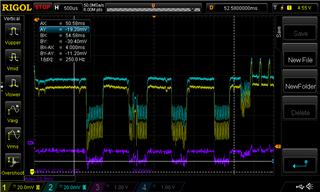I would like to confirm what I'm seeing on my setup trying to measure current with the nRF9160 DK.
I'm using an oscilloscope and am following the instructions in the latest user guide for such measurements. I have a DK that is version 0.8.5. I'm just running the asset_tracker application and am not trying to force the 9160 into any particular mode at this point. Just need to confirm what I'm seeing.
Here is an example of what I believe is happening on transmit

So, the yellow trace, channel 1, is connected to P24 on the uppermost pin (vdd nrf?) and the white trace, channel 2, is on the middle pin of P24. The bottom trace is a math function, ch1 - ch2.
Another example:

One thing I'd like to confirm is that I should be seeing that topmost pin drop below the middle pin voltage when current is being drawn. I was expecting that pin to stay more steady in voltage and the second pin to drop in voltage. Does this seem correct to you?
Thank you,
Erik


